Complete Guide for Dental Implants (2020)
Dental implants in Singapore. Here’s what you need to know.

Dental Implants in Singapore
Are you missing one or more teeth and wondering about the ideal tooth replacement solution? Dental implants replicate the function of a natural tooth and can last for a lifetime, making them the preferred choice for many patients. On the other hand, dental implants cost considerably more than dentures and may not be suitable for some people.
If you’re considering getting dental implants in Singapore, our guide will explain all you need to know about types of tooth implant, prices, and what the procedure is like.
We also recommend booking a consultation so you can discuss your treatment with an experienced implant dentist.
Here’s a complete guide to about dental implants in Singapore, we’ll cover the options available to patients and the costs involved of each treatment option before you get started.
What are Dental Implants?
Permanent Solution For Missing Teeth
A dental implant is a way to replace one or more missing teeth in a way that looks and feels natural. Implants are a permanent solution, fixed in your jaw bone just like a tooth root. With expert placement and proper care, they can last a lifetime.
For people who have been living with missing teeth or badly-fitting dentures, a fixed tooth replacement can make a real difference.
Parts of a Dental Implant
Before we look at what to expect if you get dental implants in Singapore, it’s important to understand that a tooth implant consists of three parts:
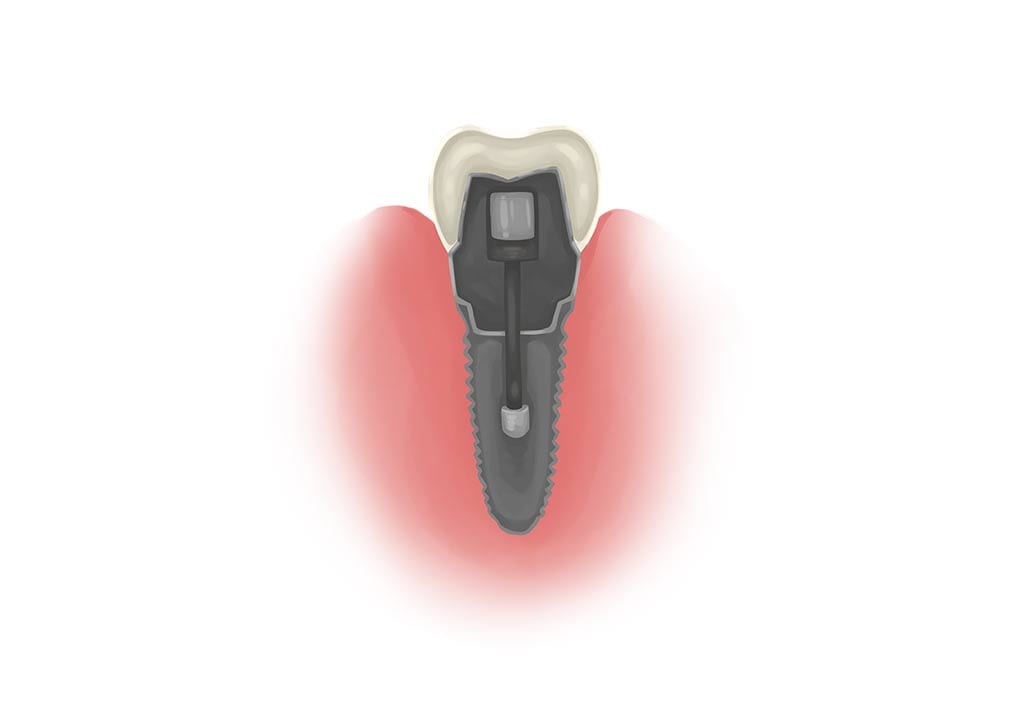
Implant screw
This is the part that is inserted into your jaw bone, mimicking the function of a tooth root. The screw shape means it can be placed precisely and firmly. It also helps with osseointegration; the process of your jaw bone fusing with the metal rod.
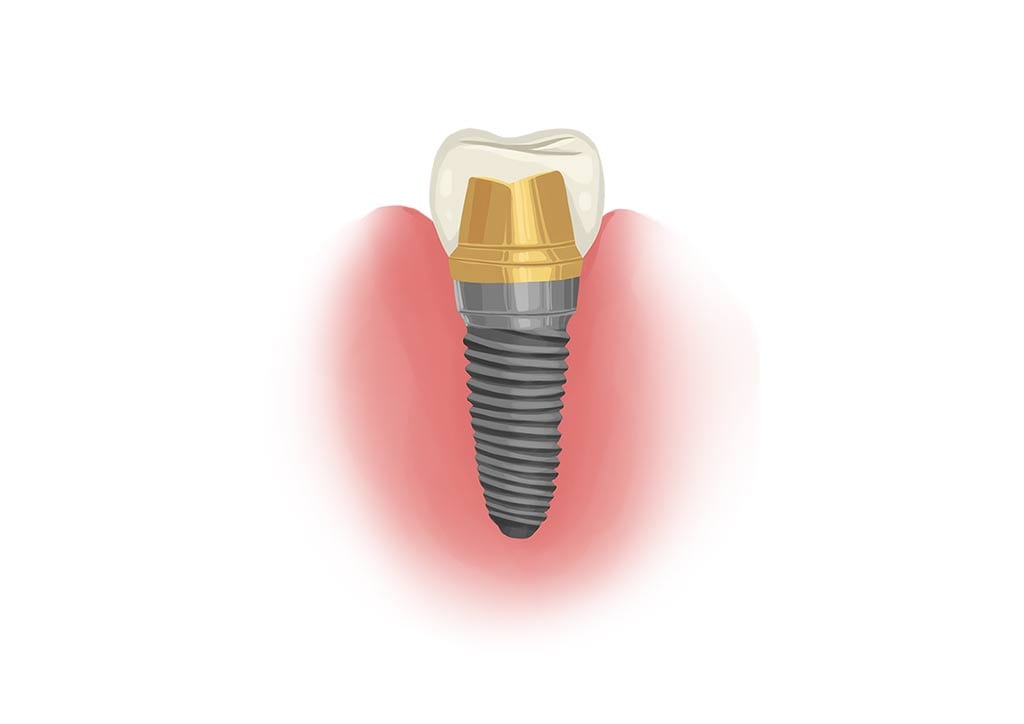
Abutment
The abutment is a small metal part which connects the implant screw to the crown on top, and holds it firmly in place.
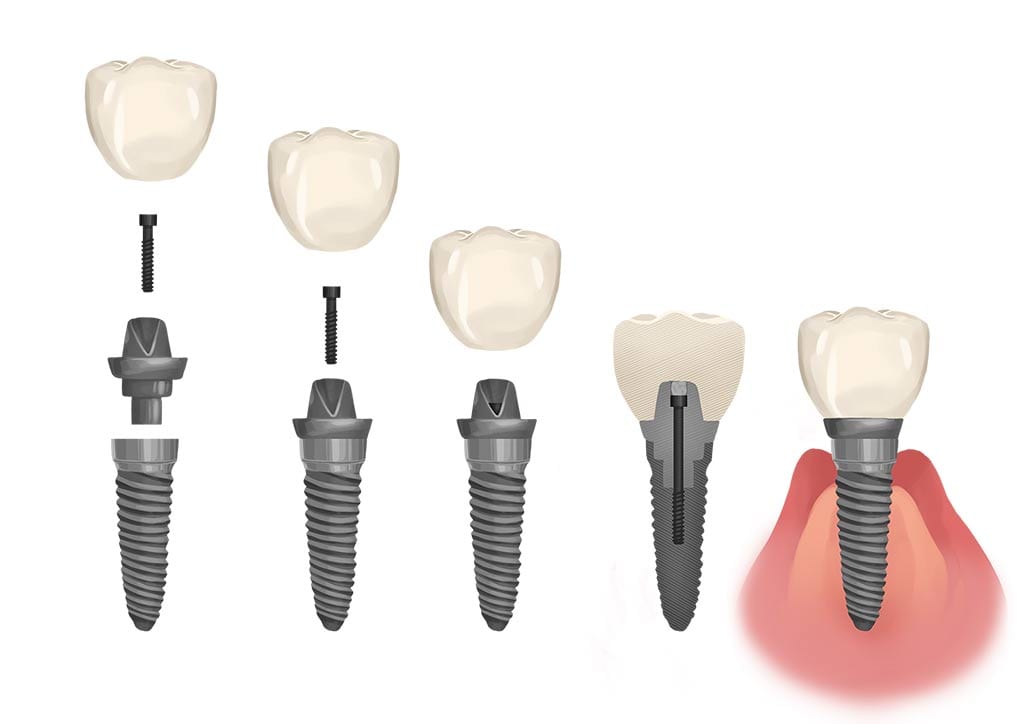
Implant Crown
Just like a traditional dental crown, the implant crown is the tooth-shaped part that’s visible above the gum line. This will be carefully designed to blend in with your remaining natural teeth, both in terms of colour and shape. An implant crown is usually made from durable ceramic material.
Types of Tooth Implants
Different Implants for Different Needs
There are several different types of dental implant available to people in Singapore. These function in different ways and will suit certain patients according to the number of missing teeth, the condition of their jaw bone, and their budget.
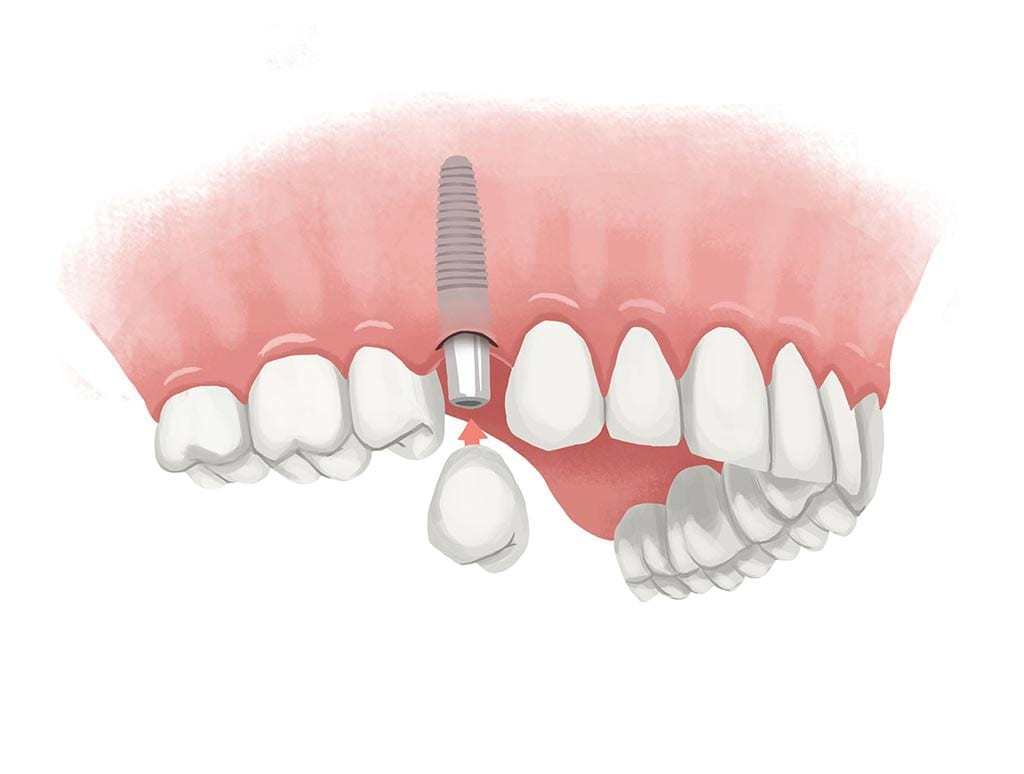
Single Dental Implant
A single tooth implant is quite simple: if you’re missing 1 tooth, a single implant can replace it. These can also be used side-by-side to fill larger gaps.
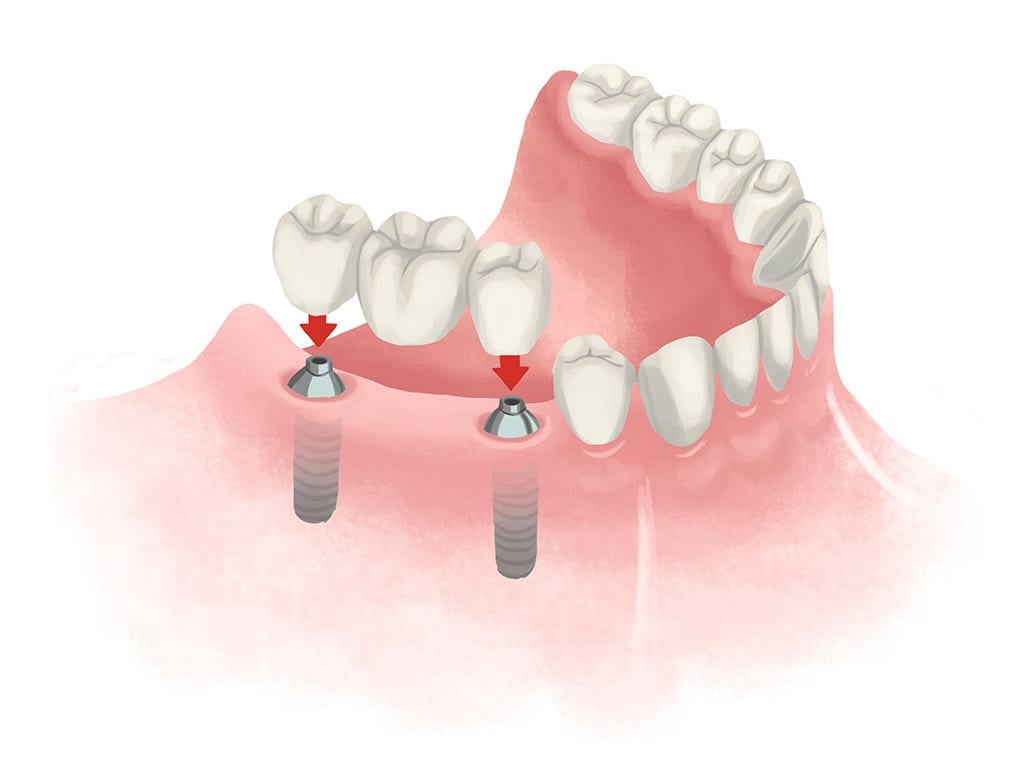
Implant Bridge
An implant bridge replaces 3 or 4 teeth in a row using just 2 supporting implants. This is more affordable than placing an individual implant for each tooth, and once in position the bridge will look like a row of natural teeth.
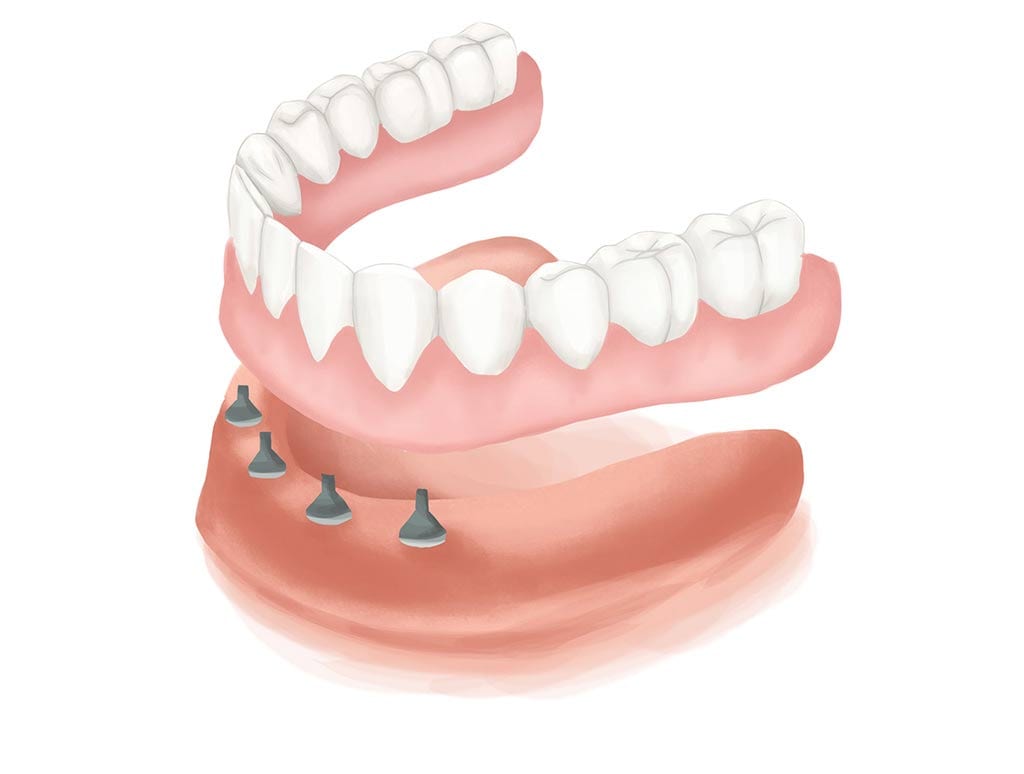
Implant Dentures
If you are missing all your teeth, or need to have the remaining ones extracted, you may be recommended denture implants (also called implant-supported dentures).
With this solution, a full jaw of false teeth is affixed to a gum-coloured acrylic base. Several implants are placed in the jaw, and these hold the denture securely in position.
With brands like All-on-4, it’s possible to anchor a full denture on just 4 or 6 implants per jaw. The implant screws are carefully angled to provide optimal support for biting and chewing.
You can also opt for full-mouth implants consisting of a series of implant bridges. Because this solution requires more implant screws than All-on-4, the cost is somewhat higher.
Dental Implants Explained
Getting Started On Dental Implants

Who Can Have Implant Teeth? Am I a Suitable Candidate?
To be a good candidate for implants, you should:
- Have generally good oral health
- Not smoke
- Have sufficient healthy jaw bone
- Have a well aligned bite
Even if your jaw bone has a low density or has been damaged by a previous dental problem, you may be able to receive a bone graft prior to having your implants placed.
When getting upper molar implants, your dentist will check the position of your sinuses on an x-ray or CT scan. If there is a risk that the implant rod will interfere with your sinuses, you may need sinus lift surgery.

Cost of Dental Implants in Singapore
The next important question to answer is: What do dental implants cost in Singapore? The short answer is that prices range from $1,250 to $6,000 for a single tooth implant (after Medisave). This price includes the implant screw, abutment and crown, as well as everything needed for a straightforward treatment.
This procedure is Medisave claimable up to $1,250 per implant.
If you need any additional procedures as part of your treatment, these will be charged for separately. Prices also vary according to the brand of implant used, the experience of your surgeon, material of the crown and the type of sedation or anaesthesia you choose.
Full mouth implant costs vary a lot depending on the condition of your mouth and the number of implant roots needed, so it’s best to book a consultation to discuss this treatment.
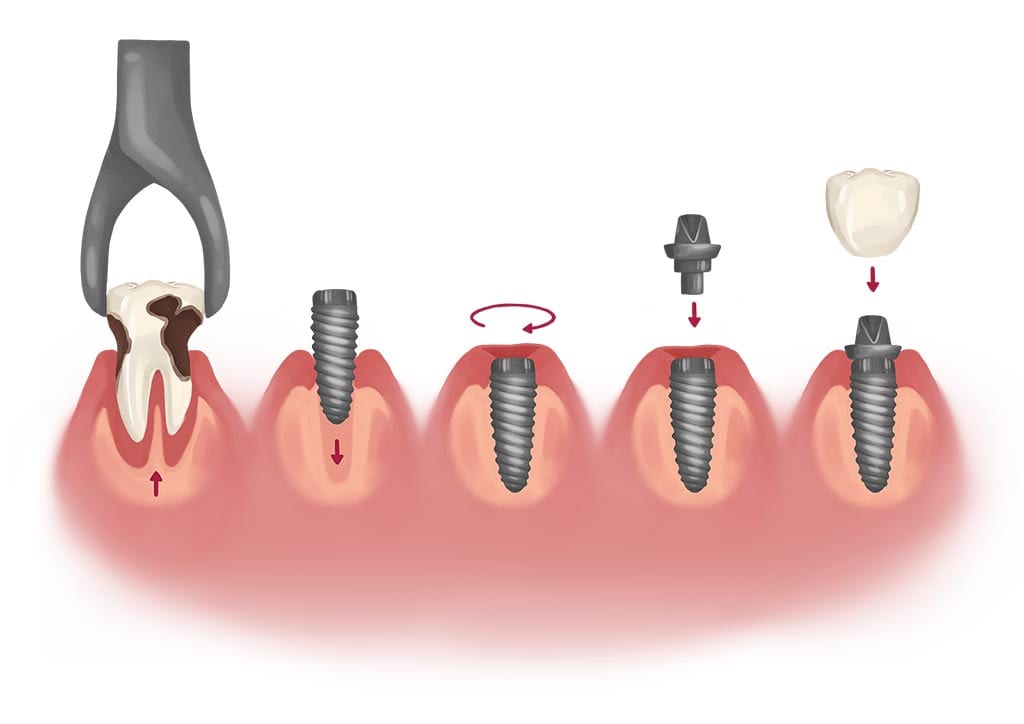
Tooth Implant Procedure
There are several steps involved with placing a dental implant, which we have outlined below. The exact procedure will depend on the type, number and position of the implants being placed, as well as the current position of your mouth and jaw bone.
Step 1: Preparation
Before beginning the surgery, your dentist will take an x-ray or CT scan to check the thickness and density of your jaw bone and precisely plan where the implant will be inserted. If you need to have any teeth extracted, this may be done several months beforehand so the bone can heal. But in some cases, extraction can be done on the same day as the implant surgery.
Step 2: Placing the implant
Implant placement involves making an incision in the gum and drilling a hole into the jaw bone. Then, the implant rod is screwed into place. Sometimes the abutment is also attached at this point. Otherwise the gum is stitched back over the implant site while it heals. You may be given a temporary crown or denture to wear until the permanent tooth is in place.
Step 3: Healing time
You can expect to feel some soreness and sensitivity for a few days after having implants placed. Your dentist will tell you what to do to aid your recovery. Once things are healed on the surface, it still takes several months for the jaw bone to properly fuse with the implant and create a strong anchor for the new tooth.
Step 4: Placing the crown, bridge or denture
The final step is to create the permanent dental prosthesis to affix to the implant screw. This will be custom-made to fit with any remaining teeth, leaving you free to eat and smile with confidence.

Alternatives to Dental Implants
If you decide against getting implants because of the cost or some other factor, it’s still a good idea to replace your missing tooth another way to preserve the surrounding teeth.
Dentures are an affordable and versatile alternative to implants. They can replace any number of missing teeth – even a full set. They might not look quite as natural as implants though, and over time as your mouth changes shape you may find that your dentures need to be relined or replaced. A set of dentures typically lasts around 5 years.
Dental bridges are also an option if you’re missing one or two adjacent teeth. This prosthesis fixes onto the two neighbouring teeth to ‘bridge’ the gap. It’s fixed in place permanently and should last for at least 10 years if cared for properly. A downside of a dental bridge is that some enamel has to be removed from healthy teeth in order to place it. With an implant, the adjacent teeth are unaffected.
Keep in mind that if you don’t get a dental implant to replace your missing tooth, you may experience bone loss which makes it harder to place an implant in the future.

Pros & Cons of Dental Implants
We’ve covered a lot of information about dental implants, so you should have a pretty good idea now of what’s involved. Here’s a quick summary of the pros and cons:
Pros
- Implant teeth look and feel natural, so you don’t need to hold back when you eat, talk and smile.
- They can replace any number of missing teeth without affecting your remaining natural teeth.
- Without teeth, face can sag and appear sunken and sad, but dental implants will come in to help maintain the natural shape of one’s face and smile.
- Dental implants help protect the healthy bone because leaving empty spaces in the mouth after losing one or more teeth can lead to additional health issues. Therefore these implants help seal the gate for bacteria and infection–causing organisms.
- Dental implants are more predictable than other teeth replacement methods. According to implant dentists, it has a track record of reliable, long-term successful outcomes and is often considered “more predictable” than other teeth replacement methods.
- Dental implants protect the healthy bone; Leaving empty spaces in the mouth after losing one or more teeth can lead to additional health issues, therefore these implants help seal the gate for bacteria and infection causing organisms.
- They mimic the function of the tooth root, maintaining your jaw bone shape and strength.
- Dental implants are built to last. That makes them the best long-term, cost-effective solution. Traditional, tooth-supported dental bridges only last five to seven years, and with proper care often more than 10 years, but at some point they may need to be replaced. (Source: https://www.ncbi.nlm.nih.gov/pmc/articles/PMC5671421/)
Cons
- Dental implants cost more than dentures or bridges.
- Some recovery time is needed after the surgical procedure.
- The process can take 6-9 months to complete.
- May require an additional bone graft or sinus lift. This can result in an increased overall cost of treatement.

In Summary
Despite improvements in dental care, millions of people still suffer tooth loss either due to tooth decay, periodontal disease, injury or accidents. For many years, the only treatment options available for people with missing teeth were dental bridges and dentures. But, today, dental implants are available.
A dental implant is an artificial tooth root that is placed into your jaw to hold a replacement tooth or bridge. Dental Implants are made of special biomaterials that are surgically placed in the jawbone under your gum line. After the surgical procedure, the implant will permanently fuse to bone become anchored into the jaw, mimicking the root of a natural tooth.
The best part is that they look and feel just like natural teeth. Dental implants are the next best thing for a healthy, natural, strong and stable teeth. A dental implant restores a lost tooth so that it looks, feels, fits and functions like a natural tooth when implanted by an experienced implant dentist.
References
- Risk factors of dental implant failure – Dentistry.co.uk
“Risk Factors Of Dental Implant Failure – Dentistry.Co.Uk”. Dentistry.Co.Uk, 2019, https://www.dentistry.co.uk/2019/10/30/risk-factors-dental-implant-failure/. Accessed 24 Oct 2020. - Replacing a Lost Tooth | Singapore Dental Health Foundation
“Replacing A Lost Tooth | Singapore Dental Health Foundation”. Dentalhealth.Org.Sg, 2020, http://dentalhealth.org.sg/replacing-a-lost-tooth/. Accessed 24 Oct 2020. - Hong, D. G. K. and Oh, J.
Hong, Do Gia Khang, and Ji-hyeon Oh. “Recent Advances In Dental Implants”. Maxillofacial Plastic And Reconstructive Surgery, vol 39, no. 1, 2017. Springer Science And Business Media LLC, doi:10.1186/s40902-017-0132-2. Accessed 24 Oct 2020.
So, What’s Next?
Interested in getting dental implants in Singapore?
If you’re looking for a natural-looking, permanent way to replace your missing teeth, implants could be the solution. To check whether you’re a good candidate and find out more about your options, contact us via our support hotline at 9007 1085 or email us at enquiry@nofrillsdental.com or message us directly to get in touch with our dentists.
We would suggest for you to speak to one of our dentists. Our dental professionals providers are experienced, ready to answer all your queries, and will discuss all the possible treatment options available for you.
At the end of the day, we believe that the right dentist for you is the one who will lay out all your treatment options on the table, allowing you to make informed decisions, while ensuring that your entire treatment process is as enjoyable, comfortable and hassle-free as possible. Good communication between you and your dentist is the best way to ensure a smooth and successful treatment.
In addition, please only proceed with the treatment if you are fully comfortable with the treatment plan proposed by your provider.
Talk to Us Today!
Related Posts
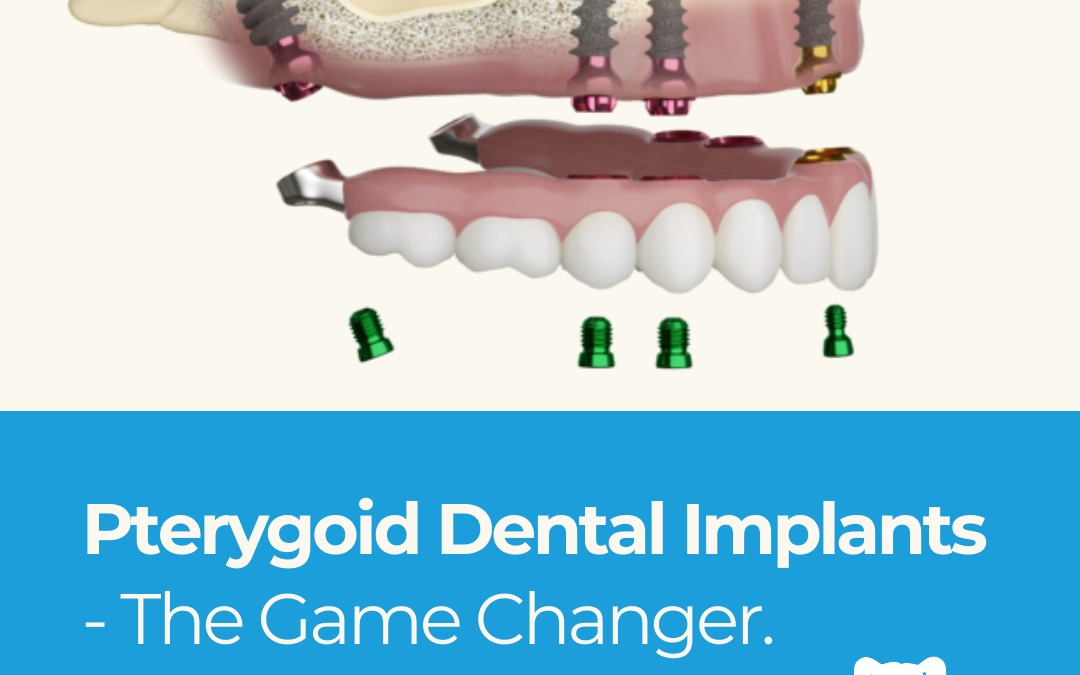
Pterygoid Dental Implants: An In-depth Guide
Dental implants have revolutionized the world of dentistry, offering solutions for patients with missing teeth. Tubero Pterygoid Dental Implants stand out due to their unique placement and advantages.

How do I prevent tartar build-up?
Tartar also known as dental calculus, develops from plaque which contains millions of bacteria that feeds on carbohydrates – sugars and starches, in the food and drinks we consume.

Effective ways to clean your Invisalign Aligners
The advanced technology of Invisalign aligners has made them a hugely popular alternative to braces for straightening teeth, among teens and adults alike.
These clear plastic appliances are more comfortable and virtually unnoticeable in the mouth, and have the further advantage of removability for brushing and flossing and meals and snacks. And they can fix less complex orthodontic problems up to twice as fast as braces.